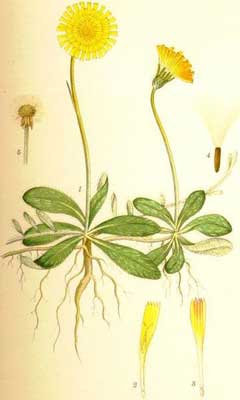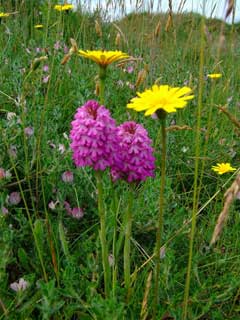 |
|
http://commons.wikimedia.org/wiki/File:Pilosella_officinarum_gr%C3%A5fibbla.jpg |
 |
| www.geograph.org.uk |
Translate this page:
Summary
Physical Characteristics

 Pilosella officinarum is a PERENNIAL growing to 0.2 m (0ft 8in) by 0.2 m (0ft 8in).
Pilosella officinarum is a PERENNIAL growing to 0.2 m (0ft 8in) by 0.2 m (0ft 8in).
See above for USDA hardiness. It is hardy to UK zone 5 and is not frost tender. It is in flower from May to August. The species is hermaphrodite (has both male and female organs) and is pollinated by Bees.
It is noted for attracting wildlife.
Suitable for: light (sandy), medium (loamy) and heavy (clay) soils, prefers well-drained soil and can grow in nutritionally poor soil. Suitable pH: mildly acid, neutral and basic (mildly alkaline) soils. It cannot grow in the shade. It prefers dry or moist soil.
UK Hardiness Map
US Hardiness Map
Synonyms
Pilosella officinarum.
Plant Habitats
Lawn; Meadow; East Wall. In. South Wall. In. West Wall. In.
Edible Uses
References More on Edible Uses
Medicinal Uses
Plants For A Future can not take any responsibility for any adverse effects from the use of plants. Always seek advice from a professional before using a plant medicinally.
Astringent Cholagogue Diaphoretic Diuretic Expectorant Tonic
Mouse-ear hawkweed relaxes the muscles of the bronchial tubes, stimulates the cough reflex and reduces the production of catarrh[254]. This combination of actions makes the herb effective against all manner of respiratory problems including asthma, wheeziness, whooping cough, bronchitis and other congested and chronic coughs[254]. The herb is mildly astringent, cholagogue, diaphoretic, strongly diuretic, expectorant and tonic[4, 7, 9, 21, 165]. The fresh plant is antibiotic[7]. The plant has been regarded as a specific for whooping cough[4] and is also used in treating other problems of the respiratory system such as asthma, bronchitis and influenza[238]. The herb is also taken in the treatment of enteritis, influenza, pyelitis and cystitis[9]. It is occasionally used externally in the treatment of small wounds and cuts[7].The plant is harvested in May and June whilst in flower and can be used fresh or dried[4, 238].
References More on Medicinal Uses
The Bookshop: Edible Plant Books
Our Latest books on Perennial Plants For Food Forests and Permaculture Gardens in paperback or digital formats.

Edible Tropical Plants
Food Forest Plants for Hotter Conditions: 250+ Plants For Tropical Food Forests & Permaculture Gardens.
More

Edible Temperate Plants
Plants for Your Food Forest: 500 Plants for Temperate Food Forests & Permaculture Gardens.
More

More Books
PFAF have eight books available in paperback and digital formats. Browse the shop for more information.
Shop Now
Other Uses
References More on Other Uses
Cultivation details
Succeeds in a sunny position in any well-drained soil[200]. Prefers a well-drained to dry poor soil in sun or partial shade[238]. A common lawn plant[1], it is also a good bee and butterfly plant[108, 200]. It grows well on the top of dry walls[200]. A strongly stoloniferous plant, it can be very invasive[200].
References Carbon Farming Information and Carbon Sequestration Information
Temperature Converter
Type a value in the Celsius field to convert the value to Fahrenheit:
Fahrenheit:
The PFAF Bookshop
Plants For A Future have a number of books available in paperback and digital form. Book titles include Edible Plants, Edible Perennials, Edible Trees,Edible Shrubs, Woodland Gardening, and Temperate Food Forest Plants. Our new book is Food Forest Plants For Hotter Conditions (Tropical and Sub-Tropical).
Shop Now
Plant Propagation
Seed - sow spring in a cold frame and only just cover the seed. When they are large enough to handle, prick the seedlings out into individual pots and plant them out in the summer. If you have sufficient seed it can be sown outdoors in situ in the spring or autumn[238]. Division in spring or autumn[238]. Very easy, larger clumps can be replanted direct into their permanent positions, though it is best to pot up smaller clumps and grow them on in a cold frame until they are rooting well. Plant them out in the spring.
Other Names
If available other names are mentioned here
Native Range
TEMPERATE ASIA: Turkey, Russian Federation-Ciscaucasia (Ciscaucasia), Armenia, Azerbaijan, Georgia, Russian Federation (Dagestan), Russian Federation-Western Siberia (Western Siberia) EUROPE: Denmark, Finland, United Kingdom, Ireland, Norway, Sweden, Austria, Belgium, Switzerland, Czech Republic, Germany, Hungary, Netherlands, Poland, Slovakia, Russian Federation (European part), Belarus, Estonia, Lithuania, Latvia, Moldova, Ukraine (incl. Krym), Albania, Bulgaria, Bosnia and Herzegovina, Greece, Croatia, Italy, North Macedonia, Montenegro, Romania, Serbia, Slovenia, Spain (incl. Baleares), France (incl. Corsica), Portugal
Weed Potential
Right plant wrong place. We are currently updating this section.
Please note that a plant may be invasive in one area but may not in your area so it's worth checking.
Conservation Status
IUCN Red List of Threatened Plants Status :

Growth: S = slow M = medium F = fast. Soil: L = light (sandy) M = medium H = heavy (clay). pH: A = acid N = neutral B = basic (alkaline). Shade: F = full shade S = semi-shade N = no shade. Moisture: D = dry M = Moist We = wet Wa = water.
Now available:
Food Forest Plants for Mediterranean Conditions
350+ Perennial Plants For Mediterranean and Drier Food Forests and Permaculture Gardens.
[Paperback and eBook]
This is the third in Plants For A Future's series of plant guides for food forests tailored to
specific climate zones. Following volumes on temperate and tropical ecosystems, this book focuses
on species suited to Mediterranean conditions—regions with hot, dry summers and cool, wet winters,
often facing the added challenge of climate change.
Read More
Expert comment
Author
F.W.Schultz.&Sch.Bip.
Botanical References
17200
Links / References
For a list of references used on this page please go here
Readers comment